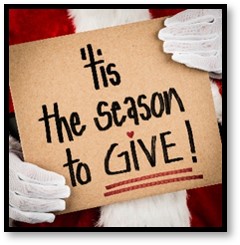Monday Author: Susanne Skinner
Americans have big hearts and charitable organizations count on our increased compassion and generosity during December. The holiday season appeals to the spirit of human kindness when it comes to giving to those who have less. We feel the juxtaposition of wealth and need in targeted advertising and appeals for charitable donations.
Hitting the Wall with Giving Fatigue
 The United States is approaching two million registered (IRS) charities, which breaks down to one for every 500 of us. That’s a lot of organizations engaged in public fundraising for tax-deductible donations—and they know where you live.
The United States is approaching two million registered (IRS) charities, which breaks down to one for every 500 of us. That’s a lot of organizations engaged in public fundraising for tax-deductible donations—and they know where you live.
Everyone feels it, but our desire to react with generosity eventually hits a wall. When giving fatigue kicks in we are less willing to respond to charitable requests because there are just too many of them. Indifference replaces compassion, along with a diminished sense of urgency and desensitization to the emotional appeal.
Cause and Effect
The pressure to donate is relentless. Our reluctance to say no, stretched budgets and perceived mismanagement of donation funds often dictates our response.
Requests come via email, robo-calling and written appeals, all with reduced open rates and lower responses. Giving comes more readily when we know the impact our donation makes, especially if it comes with a charitable tax write-off.
The standard tax deduction is $24,400 for a married couple filing jointly, $12,200 for single taxpayers, and $18,350 if you qualify as head of household. That means your itemized deductions, including charitable giving, has to exceed these amounts before you receive a tax benefit. New tax laws mean fewer people benefit from itemizing, decreasing the odds of a charitable deduction.
‘Tis the Season
Studies show 50% of charitable giving occurs in the month of December. Holiday donations to those in need make us feel better about ourselves and helping others who are less fortunate makes people happier.
 To maximize donations, appeals are often lengthy and persuasive, designed with guilt in mind. Think Sarah McLachlan’s two-minute video commercial for animal cruelty. Don’t forget the free stuff like address labels, note pads and greeting cards from charities that come with a donation card and return envelope.
To maximize donations, appeals are often lengthy and persuasive, designed with guilt in mind. Think Sarah McLachlan’s two-minute video commercial for animal cruelty. Don’t forget the free stuff like address labels, note pads and greeting cards from charities that come with a donation card and return envelope.
These charities use a portion of their donations to print and send these items and to purchase mailing lists from charities you may already support. In my house, these items go directly into the trash. The nickel or dime taped to the appeal goes into the change jar, which goes in the monthly ‘noisy offering’ at church.
You never need to feel guilty when refusing to donate to an organization.
The Donation Trap
My Dad gave generously in response and once you make a donation, you are never off the list. Religious charities, veterans’ associations, the St. Labre Indian School and Special Olympics sent monthly appeals and he sent a check. Then they sent another letter and he sent another check…
 Dad had enough dream catchers and plastic rosaries to supply the neighborhood when I shut the party down. Calling these organizations has little to no effect in stopping the requests and, after we moved, some of his junk mail followed me with our Florida address.
Dad had enough dream catchers and plastic rosaries to supply the neighborhood when I shut the party down. Calling these organizations has little to no effect in stopping the requests and, after we moved, some of his junk mail followed me with our Florida address.
On the other hand, not a Sunday went by without Dad donating to the local food pantry through his church. Growing up during the depression he often said he knew what hunger felt like and he donated from his heart.
It’s OK to Say No
It’s okay to say no, but it’s not always easy.
The best way is to appreciate the effort, then decline the request. Raising money for a cause is commendable, and I understand the time and energy it takes. Charity and not-for-profit organizations play a fundamental role in the health and well-being of the communities they support.
 However, donating all the time to whoever is asking is not possible and often means losing track of your giving. Use the following suggestions if you must respond with no:
However, donating all the time to whoever is asking is not possible and often means losing track of your giving. Use the following suggestions if you must respond with no:
- I am committed to the charities I currently supporting
- I love what your organization does but this year I am supporting [name of charity]
- I’ll read up on [your organization] and consider giving next year.
- I’m supporting [name of organization] and plan to keep supporting them.
- I’ve already allocated my charitable donations for the month/year.
Compassion Fatigue
Compassion fatigue is the indifference to charitable appeals resulting from too many requests. Graphic or repetitious advertisements with multiple examples of suffering eventually numb viewers to the tragedy and the need.
Natural disasters are a good example, as they walk a thin line between gaining sympathy and being so intrusive people are unable to relate to what they are seeing. Targeted donation appeals that help survivors make contributors feel part of something larger and emotionally rewarding.
Catastrophes can easily wipe out the donation budget of individuals and organizations. When Hurricanes Katrina and Rita hit in 2005, people everywhere stepped up but their contributions to other causes declined because they lacked the financial means to do both. Gifts of this magnitude tend to be one time only. When the crisis continues beyond the news cycle, fundraisers find ways to target and retain new donors.
Mindful Giving
Contributing at the local level benefits the giver and the organization. People are less likely to experience giving fatigue when they see their donations in action.
 Charitable giving is more than just cash; donating time and talent is just as important. The Red Cross is always in need of blood and regional food pantries welcome everything from canned goods to blankets, books and clothing. Local churches and shelters keep lists of needed items.
Charitable giving is more than just cash; donating time and talent is just as important. The Red Cross is always in need of blood and regional food pantries welcome everything from canned goods to blankets, books and clothing. Local churches and shelters keep lists of needed items.
Mindful giving can better someone else’s life situation. Guide Star and Charity Navigator are two excellent web sites to research charity ratings and performance. Charity Centers will point you to local opportunities by using your zip code.
Given the pressure to donate, especially during the holidays, be thoughtful and deliberate in your decisions. Say yes when you can, and no when you have to.
